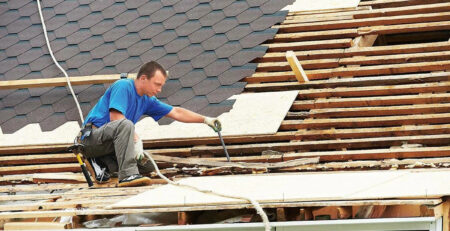What Is a Flat Roofing?
Flat roofing means the roof is almost level, not like those pointy roofs with big peaks. It’s got just a tiny slope to help water go off the edge. Flat roofs show up a lot on stores, schools, garages, offices, apartments, and more. Some homes even have a flat roof for their porch or add-on room.
Why Do People Use Flat Roofs?
Flat roofs are popular for a few reasons:
- Good for big buildings — Cheaper to build and cover big spaces
- Easy to get on top — Safer and easier for repairs, cleaning, and even putting things like AC units up there
- Extra space — People use flat roofs for gardens, patios, solar panels, or storage
A neighbor built a flat roof for his new sunroom so he could put up a small garden. He said it’s easier to fix than his regular roof.

What Are Flat Roofs Made Of?
Flat roofs don’t work with normal shingles. Instead, they use:
- Rubber (EPDM): Strong, flexible, and lasts long
- TPO: Shiny and white, keeps places cooler
- Tar and Gravel (BUR): Layers of tar covered with gravel
- Modified Bitumen: Rolled-up material that sticks down and blocks water
Every option has good points and things to watch for. Rubber and TPO are popular because they make water run off better and are easy to patch if there’s a problem.

How Does a Flat Roof Stay Dry?
Flat roofs aren’t truly, totally flat. There’s always a bit of tilt so rain goes to a drain or gutter. Without that tiny slope, water would just sit there and soak in after every storm.
There are roof drains, gutters, or scuppers (little holes in the wall) to pull away the water. These have to stay clean, or leaks start fast.
Common Flat Roof Problems
Flat roofs can be tough, but:
- Standing water is bad news, when drains get blocked, puddles show up and weaken the roof
- Leaks come from cracks or around pipes and vents
- Blisters (bubbles) are from too much heat or bad drainage, and often turn into leaks
- Moss and mold grows when puddles hang around too long
- Rips or holes might be from tree branches, hail, or people walking on the roof
One business owner told me he found a tennis ball blocking his drain after a storm. Getting that unstuck stopped a leak before it got worse.
Can You Walk On Flat Roofs?
Most flat roofs can handle some walking for repairs or cleaning, but always be careful. Some older roofs get soft or squishy, and stepping wrong can make cracks. Roofers have special tools and know how to check if it’s safe.
How To Keep a Flat Roof Working Well
A few simple steps help:
- Clean leaves and junk from drains and gutters every spring and fall
- Look for puddles after a rain, if water stays for over a day, it needs checking
- Trim tree branches near flat roofs so nothing can poke or drop leaves
- Get a pro inspection every year for cracks, soft spots, or musty smells inside
Regular checks almost always cost less than emergency repairs later!
Do Flat Roofs Last a Long Time?
Usually, flat roofs last 15–25 years. It depends on what they’re made of and how well someone keeps them clean. If it’s leaking often, feels soft, or there are tons of blisters, it might be time for a bigger fix or replacement.
Should You Pick a Flat Roof?
Flat roofs are great for lots of buildings, big spaces, or if you want extra room on top. But they need more cleaning and a bit more attention than regular pointed roofs. If the building is in a spot that gets tons of rain or sticks, plan for more roof checks each year.
Final Thoughts
Flat roofing isn’t fancy or strange, it’s just a different way to keep water out and cover your building. The biggest trick is regular cleaning and looking for problems early. If you catch small leaks or blocked drains before they get nasty, flat roofs last a long time and work great.
Questions about your flat roof? It’s always smart to get a roofing contractor to do an inspection if you’re unsure. Regular care means fewer headaches and more years of working roof over your head.











